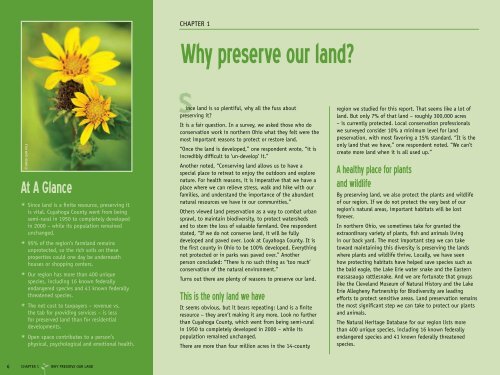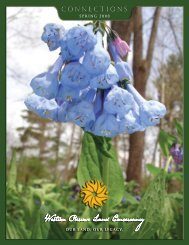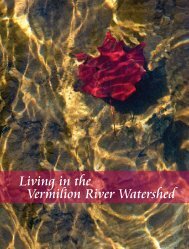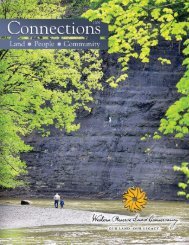Common Ground - Western Reserve Land Conservancy
Common Ground - Western Reserve Land Conservancy
Common Ground - Western Reserve Land Conservancy
You also want an ePaper? Increase the reach of your titles
YUMPU automatically turns print PDFs into web optimized ePapers that Google loves.
© DAVID LIAM KYLE<br />
At A Glance<br />
* Since land is a finite resource, preserving it<br />
* 95% of the region’s farmland remains<br />
* Our region has more than 400 unique<br />
* The net cost to taxpayers – revenue vs.<br />
* Open space contributes to a person’s<br />
is vital. Cuyahoga County went from being<br />
semi-rural in 1950 to completely developed<br />
in 2000 – while its population remained<br />
unchanged.<br />
unprotected, so the rich soils on these<br />
properties could one day be underneath<br />
houses or shopping centers.<br />
species, including 16 known federally<br />
endangered species and 41 known federally<br />
threatened species.<br />
the tab for providing services – is less<br />
for preserved land than for residential<br />
developments.<br />
physical, psychological and emotional health.<br />
66 CHAPTER CHAPTER 1 1 WHY PRESERVE PRESERVE OUR OUR LAND LAND<br />
CHAPTER 1<br />
Why preserve our land?<br />
S ince land is so plentiful, why all the fuss about<br />
preserving it?<br />
It is a fair question. In a survey, we asked those who do<br />
conservation work in northern Ohio what they felt were the<br />
most important reasons to protect or restore land.<br />
“Once the land is developed,” one respondent wrote, “it is<br />
incredibly difficult to ‘un-develop’ it.”<br />
Another noted, “Conserving land allows us to have a<br />
special place to retreat to enjoy the outdoors and explore<br />
nature. For health reasons, it is imperative that we have a<br />
place where we can relieve stress, walk and hike with our<br />
families, and understand the importance of the abundant<br />
natural resources we have in our communities.”<br />
Others viewed land preservation as a way to combat urban<br />
sprawl, to maintain biodiversity, to protect watersheds<br />
and to stem the loss of valuable farmland. One respondent<br />
stated, “If we do not conserve land, it will be fully<br />
developed and paved over. Look at Cuyahoga County. It is<br />
the first county in Ohio to be 100% developed. Everything<br />
not protected or in parks was paved over.” Another<br />
person concluded: “There is no such thing as ‘too much’<br />
conservation of the natural environment.”<br />
Turns out there are plenty of reasons to preserve our land.<br />
This is the only land we have<br />
It seems obvious, but it bears repeating: <strong>Land</strong> is a finite<br />
resource – they aren’t making it any more. Look no further<br />
than Cuyahoga County, which went from being semi-rural<br />
in 1950 to completely developed in 2000 – while its<br />
population remained unchanged.<br />
There are more than four million acres in the 14-county<br />
region we studied for this report. That seems like a lot of<br />
land. But only 7% of that land – roughly 300,000 acres<br />
– is currently protected. Local conservation professionals<br />
we surveyed consider 10% a minimum level for land<br />
preservation, with most favoring a 15% standard. “It is the<br />
only land that we have,” one respondent noted. “We can’t<br />
create more land when it is all used up.”<br />
A healthy place for plants<br />
and wildlife<br />
By preserving land, we also protect the plants and wildlife<br />
of our region. If we do not protect the very best of our<br />
region’s natural areas, important habitats will be lost<br />
forever.<br />
In northern Ohio, we sometimes take for granted the<br />
extraordinary variety of plants, fish and animals living<br />
in our back yard. The most important step we can take<br />
toward maintaining this diversity is preserving the lands<br />
where plants and wildlife thrive. Locally, we have seen<br />
how protecting habitats have helped save species such as<br />
the bald eagle, the Lake Erie water snake and the Eastern<br />
massasauga rattlesnake. And we are fortunate that groups<br />
like the Cleveland Museum of Natural History and the Lake<br />
Erie Allegheny Partnership for Biodiversity are leading<br />
efforts to protect sensitive areas. <strong>Land</strong> preservation remains<br />
the most significant step we can take to protect our plants<br />
and animals.<br />
The Natural Heritage Database for our region lists more<br />
than 400 unique species, including 16 known federally<br />
endangered species and 41 known federally threatened<br />
species.









